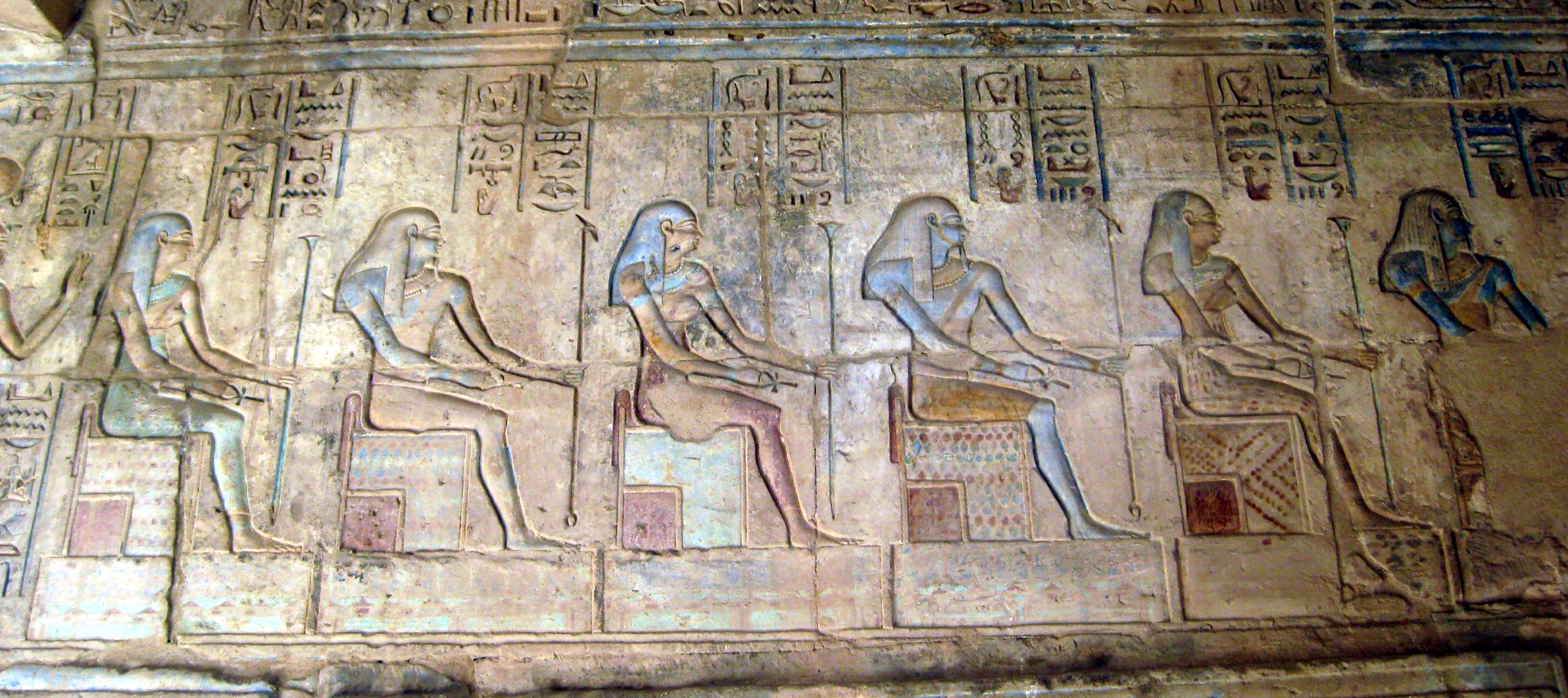Ogdoad (Egyptian) on:
[Wikipedia]
[Google]
[Amazon]

 In
In
File:Kek god.svg, Kek and other male members
File:Kauket.svg, Kauket and other female members
File:Heh as chaos.svg, Nu
File:Heh.svg, Ḥeḥ
File:Amun post Amarna (azure skin color).svg,
The names of Nu and Naunet are written with the determiners for
Maat, the Moral Ideal in Ancient Egypt: A Study in Classical African Ethics
p.177
Psychology Press, 2004 - Volume 70 of
Orientalia Lovaniensia analecta
'.
 In
In Egyptian mythology
Egyptian mythology is the collection of myths from ancient Egypt, which describe the actions of the Egyptian pantheon, Egyptian gods as a means of understanding the world around them. The beliefs that these myths express are an important part ...
, the Ogdoad ( "the Eightfold"; , a plural nisba of "eight") were eight primordial deities worshiped in Hermopolis.
The earliest certain reference to the Ogdoad is from the Eighteenth Dynasty, in a dedicatory inscription by Hatshepsut
Hatshepsut ( ; BC) was the sixth pharaoh of the Eighteenth Dynasty of Ancient Egypt, Egypt, ruling first as regent, then as queen regnant from until (Low Chronology) and the Great Royal Wife of Pharaoh Thutmose II. She was Egypt's second c ...
at the Speos Artemidos.
Texts of the Late Period describe them as having the heads of frogs (male) and serpents (female), and they are often depicted in this way in reliefs of the last dynasty, the Ptolemaic Kingdom
The Ptolemaic Kingdom (; , ) or Ptolemaic Empire was an ancient Greek polity based in Ancient Egypt, Egypt during the Hellenistic period. It was founded in 305 BC by the Ancient Macedonians, Macedonian Greek general Ptolemy I Soter, a Diadochi, ...
.
Names
The eight deities were arranged in four male–female pairs. The names have the same meanings and differ only slightly.Attributes
Amun
Amun was a major ancient Egyptian deity who appears as a member of the Hermopolitan Ogdoad. Amun was attested from the Old Kingdom together with his wife Amunet. His oracle in Siwa Oasis, located in Western Egypt near the Libyan Desert, r ...
File:Amunet.svg, Amunet
sky
The sky is an unobstructed view upward from the planetary surface, surface of the Earth. It includes the atmosphere of Earth, atmosphere and outer space. It may also be considered a place between the ground and outer space, thus distinct from ...
and water
Water is an inorganic compound with the chemical formula . It is a transparent, tasteless, odorless, and Color of water, nearly colorless chemical substance. It is the main constituent of Earth's hydrosphere and the fluids of all known liv ...
, and it seems clear that they represent the primordial waters.
Ḥeḥ and Ḥeuḥet have no readily identifiable determiners; according to a suggestion due to Brugsch (1885), the names are associated with a term for an undefined or unlimited number, ''ḥeḥ'', suggesting a concept similar to the Greek '' aion''. From the context of a number of passages in which Ḥeḥu is mentioned, however, Brugsch also suggested that the names may be a personification of the atmosphere between heaven and earth (c.f. '' Shu'').
The names of Kek and Kauket are written with a determiner combining the sky hieroglyph with a staff or scepter used for words related to darkness and obscurity, and kkw as a regular word means "darkness", suggesting that these gods represent primordial darkness, comparable to the Greek Erebus, but in some aspects they appear to represent day as well as night, or the change from night to day and from day to night.
The fourth pair has no consistent attributes as it appears with varying names; sometimes the name ''Qerḥ'' is replaced by ''Ni, Nenu, Nu, or Amun
Amun was a major ancient Egyptian deity who appears as a member of the Hermopolitan Ogdoad. Amun was attested from the Old Kingdom together with his wife Amunet. His oracle in Siwa Oasis, located in Western Egypt near the Libyan Desert, r ...
'', and the name ''Qerḥet'' by ''Ennit, Nenuit, Nunu, Nit, or Amunet''. The common meaning of ''qerḥ'' is "night", but the determinative (D41 for "to halt, stop, deny") also suggests the principle of inactivity or repose.
There is no obvious way to allot or attribute four functions to the four pairs of deities; Budge postulates that "the ancient Egyptians themselves had no very clear idea" regarding such functions. Nevertheless, there have been attempts to assign "four ontological concepts"
to the four pairs: For example, in the context of the New Kingdom, Karenga (2004) uses "fluidity" (for "flood, waters"), "darkness", "unboundedness", and "invisibility" (or "repose, inactivity"). Maulana Karenga (2004) Maat, the Moral Ideal in Ancient Egypt: A Study in Classical African Ethics
p.177
Psychology Press, 2004 - Volume 70 of
Orientalia Lovaniensia analecta
'.
See also
* EnneadReferences
Bibliography
* * * * * *External links
* {{Ancient Egyptian religion footer Groups of Egyptian deities Creation myths Octets in religion ca:Llista de personatges de la mitologia egípcia#O